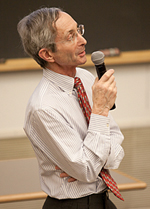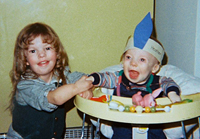

Human Face on Cells and Molecules
Molecular and Cellular Foundations of Medicine Puts a Human Face on Cells and Molecules
What do you say to a parent who has a child born with congenital malformations? That was a question posed by pediatric geneticist Dr. Robert Marion during a compelling interview with Debbie Jorde conducted before Einstein's first-year students at the conclusion of their Molecular and Cellular Foundations of Medicine (MCFM) course. The mother of two children born with extremely rare genetic disorders, Mrs. Jorde came to Einstein to discuss the many challenges that genetic abnormalities pose for patients and their families. She also shared her family's experience as the first to have each member's entire genome sequenced.

Dr. Howard Steinman introduces the course's special guestsWhole genome sequencing, or WGS, is an emerging technology that is expected to become a state-of-the-art clinical test in the future. It is a concept the Einstein students have heard about during the first 25 weeks of the MCFM course, where they learned the role that genetics plays in many of the disorders and abnormalities they will encounter as physicians, and about other molecular and cellular concepts fundamental to the practice of medicine.
In week 26, though, Dr. Marion, who is director of Einstein's Children's Evaluation and Rehabilitation Center, offers a memorable grand finale, interviewing a parent and/or patient who paints a poignant picture of what it means to live with a genetic disorder. The human face offered through the interviewee's responses help to reinforce the details students have learned about molecules and cells during MCFM.
Dr. Marion noted, "Debbie Jorde's visit was particularly special because, in this instance, the students got to hear from a woman whose family has helped to pioneer a new technology, which in turn helped them to identify two sets of mutations that were responsible for two separate genetic disorders." (The Jorde's story was published in the journal Science, Roach et al, 328:636, 2010, and covered in many media outlets, most notably the New York Times.)
"From the very start of MCFM, we tell our future clinicians that genetics and, in particular, direct-to-consumer marketing of genetic tests will be an increasing part of their clinical practice," explained Dr. Howard Steinman, assistant dean for biomedical science education. "While the course is about molecules and cells, one of my goals as course director is to ensure that our first-year students don't lose sight of their patients as people."

Heather and Logan Madsen at three-and-a-half and six monthsTo achieve that aim, throughout the MCFM course, students take part in or watch video interviews of people with sickle cell anemia, cystic fibrosis, Marfan syndrome, HIV, rheumatoid arthritis, Type 1 diabetes and BRCA-positive breast cancer. However, it is the end-of-course interview conducted by Dr. Marion that Dr. Steinman hopes will leave a lasting impression on the students as they move on to their organ physiology courses.
This year's interview with Mrs. Jorde will not soon be forgotten. Preceded by a special lecture, "The Future of Genetic Medicine: Promise and Pitfalls," presented by Einstein's dean Dr. Allen M. Spiegel, Mrs. Jorde's interview reminded students in plain but strong language that "patients are not a syndrome, they are not a symptom. They are people and they have feelings."
The interview also drove home the stark reality that genetic disorders affect more than just the child. "The mother is the patient, the father is the patient, and the extended family is, too," noted Dr. Marion.

Heather writingMrs. Jorde (then Debbie Madsen) delivered the first of her two children, a baby girl named Heather, in 1977, when she was 21 years old. The Salt Lake City, Utah resident related the first moments following her daughter's delivery: "They pulled Heather out of my body and the doctor said ‘You have a girl,' and placed her on my abdomen. My eyes locked on her bent arms and my mind started racing, thinking, her arms are bent. Then denial set right in: No, they're not bent. After she's outside me a while they'll straighten out.
"Then I heard her dad say, ‘Something's wrong with her arms,' and I couldn't deny it. Timidly, I said to the doctor ‘Is everything else okay?' and he said, ‘I'm sorry Debbie, but the baby only has eight fingers and eight toes.'"
She soon learned that the bent arms and reduced number of fingers and toes were part of a litany of problems for her newborn. Heather also had a cleft palate that would not allow her to be breast-fed, a heart murmur, and difficulty breathing. Doctors also were not certain whether she could see or hear. There was grave concern over whether she would survive.
While her doctors could determine Heather's multiple problems, they could not identify what caused them. An initial diagnosis was Treacher-Collins syndrome, even though that disorder is known to affect facial features but not limbs.
It wasn't until Heather was a year-and-a-half old that a doctor told Mrs. Jorde "I don't think she has Treacher-Collins. She has postaxial acrofacial dysostosis, or Miller syndrome." The disorder is so rare that only two other cases were known at the time, and the Madsens still didn't know what caused it. Nonetheless, they were assured that having another baby with the syndrome was a "one-in-a-million" possibility.

Logan paintingThree years later, when their son Logan was born, they learned otherwise. Mrs. Jorde recalled, "The doctor slapped me on the leg and said, ‘Congratulations. You just made medical history.'"
Indeed, Logan had the same exact defects as his sister, requiring intensive care and surgery. Between them, the siblings have undergone between 40 and 50 surgeries. Both have lung problems from a second condition, known as primary ciliary dyskinesia (PCD), which affects their ability to stave off infections. And more recently, both siblings were diagnosed with differing, high-functioning autism spectrum disorders.
In a book she wrote about her experience, aptly titled Eight Fingers and Eight Toes, Mrs. Jorde details her family's experiences dealing with Heather and Logan's health and physical challenges resulting from the disorders, as well as their participation in a research study, which led them to become the first family to have their entire genome sequenced.
"When we were asked if we wanted to participate in the whole genome sequencing study, we enthusiastically responded "Yes!" she recalled. "When we learned that Miller syndrome is caused by a genetic defect, my eyes filled with tears of happiness. Just having the answer is huge, even if they don't have a cure."
The whole genome sequencing also demonstrated that they had PCD, which also was the result of a genetic defect. "We hadn't known what caused Heather and Logan's lung problems, so knowing that was big, too," she added. "Heather described it best when she said, ‘Now we know it's just Mother Nature working things out.'"

Logan and Heather flank their mom, Debbie JordeMrs. Jorde continued, "Before, we had to tell people we didn't know, and that was hard. The findings tied up loose ends. But it's also nice to know we've contributed to something that will give others answers."
With her visit to Einstein's MCFM course, Mrs. Jorde provided important answers to a number of questions, including what a doctor should say to a parent whose child is born with birth defects. "I think the most important thing is just saying ‘I care about you and I'm thinking about you, and I want to do everything I can to help you through this," she said.
Dr. Marion concurred, adding, "A lot of times there's not anything we can do, but we can be there for you, hold your hand and help your through what's happening."
Today, Heather and Logan live as independently as they can in their own homes. Heather, a writer, recently turned 34 and has a boyfriend who helps with her care. Logan turned 31 on April Fool's Day. He is an artist and has a dog.
To listen to Dr. Marion's entire interview with Mrs. Jorde, click on Einstein MCFM. For more information about Miller syndrome and PCD, visit the websites http://www.nagerormillersynd.com/ and http://www.pcdfoundation.org/, respectively.
Family photos courtesy of Debbie Jorde
Additional details about Mrs. Jorde's book and the Madsen family story can be accessed at the links below:
"Eight Fingers and Eight Toes" Facebook page
SLTribune News story about book "Eight Fingers and Eight Toes"
KSL News story genome sequencing, Heather and Logan Feb 15, 2011
Posted on: Thursday, April 28, 2011


